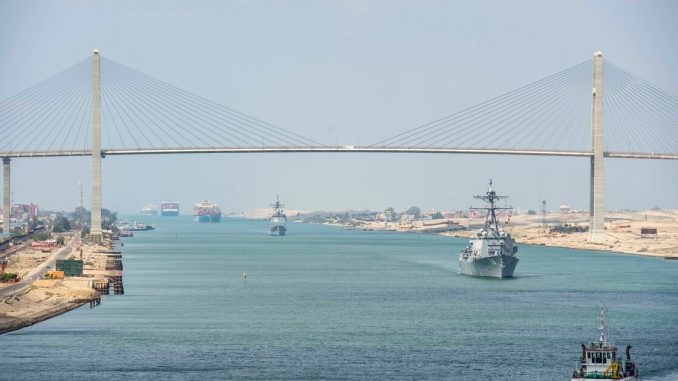
The aircraft carrier Dwight. D. Eisenhower and its carrier strike group transited the Suez Canal on April 2 — days after the Taiwanese cargo ship Ever Given was freed after blocking the canal.
The carrier strike group comprised the first U.S. warships to transit the canal after it was cleared, and they subsequently continued into the Red Sea, according to U.S. Naval Forces Central Command.
“We appreciate the Government of Egypt and Suez Canal Authority’s efforts to ensure the safety of navigation in this critical waterway for all ships, and in allowing the IKE CSG to transit so quickly,” Vice Adm. Samuel Paparo, commander of U.S. Naval Forces Central Command, U.S. 5th Fleet and Combined Maritime Forces, said in a Navy news release.
The aircraft carrier Dwight D. Eisenhower and its strike group transit the Suez Canal April 2. (MC3 Connor Houghtaling and Cameron Pinske, and MCSN Orion Shotton, Aimie Ford and Mo Bourdi/Navy)
According to the Navy, Ike will devote attention to working and training with regional and coalition partners, and also providing naval aviation support to Operation Inherent Resolve as it operates in the 5th Fleet.
“Our strike group is excited to sail and fly in the conduct of our operations in the Red Sea,” said Rear Adm. Scott F. Robertson, Commander Carrier Strike Group 2. “The importance of our regional partnerships throughout U.S. Fifth Fleet cannot be overstated and enhancing our relationship with Egypt is a continuation in fostering both trust and unity in our enduring maritime efforts.”
/cloudfront-us-east-1.images.arcpublishing.com/mco/6CGXVESPZFABZA7TKNYRVYNDFQ.jpg)
Last week, the Navy announced that Ike and its carrier strike group had started to launch flight operations against the Islamic State from the Mediterranean Sea. There, the service said, the carrier had the ability to support three different combatant commands.
Ike left Norfolk in February to get started on its second deployment in a year. The carrier wrapped up its 2020 deployment in August, racking up 205 continuous days at sea as a result of the COVID-19 pandemic.
Those currently deployed with Ike’s carrier strike group include guided-missile cruiser Monterey, and guided-missile destroyers Mitscher, Laboon, Mahan and Thomas Hudner.
The aircraft carrier Nimitz was the last carrier to operate in the Middle East, and returned to San Diego in February after an almost 11-month deployment, which was extended in January due to perceived threats from Iran.
But the Navy and the Department of Defense were tight-lipped about whether already deployed carriers Ike or Theodore Roosevelt would step in and operate in the Middle East in light of the Nimitz’s absence from the region.
/arc-anglerfish-arc2-prod-mco.s3.amazonaws.com/public/66NJBCO6PVGR5AM7OJTH33KJWE.JPG)
“It is, as you all know, a balancing act between requirements and the capabilities on hand,” Pentagon spokesman John Kirby told reporters in February when asked about a replacement for the Nimitz. “The secretary believes that we have a robust presence in the Middle East to respond. It’s a constant discussion that he has with the Central Command commander, as well as the combatant commanders in other parts of the world.”
This isn’t the first time in recent years that Ike has operated in the Middle East. Ike — along with aircraft carrier Harry S. Truman — also both operated in CENTCOM’s area of operations in 2020 in response to heightened tension with Iran.



Be the first to comment